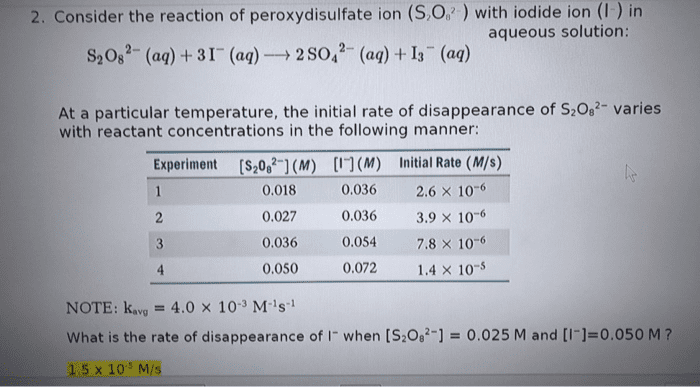Consider the reaction of peroxydisulfate ion (S2O2â8) with iodide ion (Iâ) in aqueous solution:
S2O2â8(aq)+3Iâ(aq)â2SO2â4(aq)+Iâ3(aq).
At a particular temperature the rate of disappearance of S2O2â8 varies with reactant concentrations in the following manner:
Experiment S2O2â8(M) Iâ(M) Initial Rate (M/s) 1 0.018 0.036 2.6Ã10â6 2 0.027 0.036 3.9Ã10â6 3 0.036 0.054 7.8Ã10â6 4 0.050 0.072 1.4Ã10â5
Part A
Determine the rate law for the reaction.
A) rate=k[S2O2â8]2[Iâ] B) rate=k[S2O2â8][Iâ]2 C) rate=k[S2O2â8][Iâ] D) rate=k[S2O2â8]2[Iâ]2
Part B
What is the average value of the rate constant for the disappearance of S2O2â8 based on the four sets of data?
Part C
How is the rate of disappearance of S2O2â8 related to the rate of disappearance of Iâ?
A) the rate of disappearance of Iâ is one-third the rate of disappearance of S2O2â8 B) the rate of disappearance of S2O2â8 is one-third the rate of disappearance of Iâ C) the rate of disappearance of S2O2â8 is equal to the rate of disappearance of Iâ
Part D
What is the rate of disappearance of Iâ when [S2O2â8]= 3.5Ã10â2 M and [Iâ]= 5.0Ã10â2 M ?
Express your answer using two significant figures.
Consider the reaction of peroxydisulfate ion (S2O2â8) with iodide ion (Iâ) in aqueous solution:
S2O2â8(aq)+3Iâ(aq)â2SO2â4(aq)+Iâ3(aq).
At a particular temperature the rate of disappearance of S2O2â8 varies with reactant concentrations in the following manner:
| Experiment | S2O2â8(M) | Iâ(M) | Initial Rate (M/s) |
| 1 | 0.018 | 0.036 | 2.6Ã10â6 |
| 2 | 0.027 | 0.036 | 3.9Ã10â6 |
| 3 | 0.036 | 0.054 | 7.8Ã10â6 |
| 4 | 0.050 | 0.072 | 1.4Ã10â5 |
Part A
Determine the rate law for the reaction.
| A) rate=k[S2O2â8]2[Iâ] |
| B) rate=k[S2O2â8][Iâ]2 |
| C) rate=k[S2O2â8][Iâ] |
| D) rate=k[S2O2â8]2[Iâ]2 |
Part B
What is the average value of the rate constant for the disappearance of S2O2â8 based on the four sets of data?
Part C
How is the rate of disappearance of S2O2â8 related to the rate of disappearance of Iâ?
| A) the rate of disappearance of Iâ is one-third the rate of disappearance of S2O2â8 |
| B) the rate of disappearance of S2O2â8 is one-third the rate of disappearance of Iâ |
| C) the rate of disappearance of S2O2â8 is equal to the rate of disappearance of Iâ Part D What is the rate of disappearance of Iâ when [S2O2â8]= 3.5Ã10â2 M and [Iâ]= 5.0Ã10â2 M ? Express your answer using two significant figures. |

